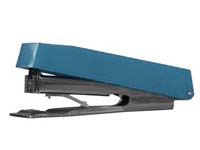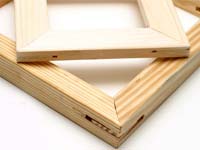| Glossary Of Giclee Terms
[21] |
S
Satin Finish As opposed to the high shine of a glossy finish, satin finish has what is referred to as a sheen - a smoother, velvet-like softness. It is closer to a matte finish, but slightly more reflective. |
Saturation Saturation, also known as chroma or intensity, refers to the purity or vividness of a color, representing the degree to which it appears rich, vibrant, or intense. Highly saturated colors appear vivid and distinct, while desaturated colors appear duller or washed out. HSL, which stands for Hue, Saturation, and Luminance, is a color model used in digital image processing and editing to manipulate and adjust the colors within an image. Each component of the HSL color model represents a different aspect of color:
Hue: Hue refers to the pure color of an object, represented as a point on the color wheel. It defines the specific wavelength of light that is perceived by the human eye, ranging from red to orange, yellow, green, cyan, blue, and violet.
Saturation: Saturation determines the intensity or purity of a color. A fully saturated color appears vivid and vibrant, while a desaturated color contains more gray and appears dull or muted.
Luminance: Luminance refers to the brightness or lightness of a color. It represents the amount of light reflected by an object or surface, ranging from black (0% luminance) to white (100% luminance).
By adjusting the values of hue, saturation, and luminance independently, photographers and digital artists can fine-tune and manipulate the colors within an image to achieve desired visual effects, correct color casts, or enhance the overall color balance. |
Scanning Scanning is the process of converting physical documents, photographs, or images into digital format using a scanner or scanning device. During scanning, the scanner captures the optical characteristics of the original document or image and converts them into digital data, typically in the form of a raster image file (e.g., JPEG, TIFF, PNG). Scanning is commonly used for digitizing printed documents, photographs, artwork, and other visual materials for storage, distribution, manipulation, and display in electronic formats.
Order your high quality artwork scan with our easy, online order system. |
 |
| Schiele, Egon (1890-1918) An Austrian painter mentored by Gustav Klimt, who is known for his raw imagery. We offer classic art prints by Egon Schiele. |
 |
| Self-leveling A variety of viscous products that will spread until the surface is even, without any need for manual smoothing. For example: resin coating. |
| Sepia A treatment that can be digitally applied to an image to give make it brown-tinted monotone in color. Sepia is meant to mimic the color of developed film photographs from the early and mid 20th century. |
 |
Sharpness Sharpness refers to the clarity and definition of details in an image, including fine textures, edges, and contours. A sharp image exhibits well-defined edges, crisp details, and high contrast between adjacent elements, resulting in a clear and visually pleasing appearance. Sharpness is influenced by various factors, including camera settings, lens quality, focus accuracy, and image processing techniques. Achieving optimal sharpness requires careful attention to these factors during image capture and post-processing.
While sharpness is often desirable in photography, it's important to recognize that the perceived level of sharpness can vary depending on factors such as viewing distance, display size, and image content. Photographers may choose to adjust sharpness settings during post-processing to enhance image clarity and visual impact, taking into account the specific characteristics and requirements of each image. |
| Shellac A liquid coating derived from the excretion of a beetle found in India and Thailand. When the dried flakes are mixed with ethanol, they become a natural primer that dries solid and serves as a protective insulator, sealant or stain. Today, real shellac has been largely replaced by chemically-produced lacquer. |
Silicone Paper A type of paper that is treated with a silicone coating which prevents it from sticking to whatever it is laid against. Often used to separate artworks from one another, or placed over an artwork prior to rolling, so it does not stick to itself.
Similar to Release Paper. |
| Sintra Sintra is lightweight PVC board. Sintra has a uniform, fine, closed-cell structure that provides a low gloss satin finished surface. They are highly rigid and impact resistant. Durable for interior and exterior applications with a very high aversion to corrosion & water absorption. They are self-extinguishing and flame resistant. Available in black or white, 3mm(1/8") & 6mm(1/4") thicknesses. |
| Sisley, Alfred (1839-1899) A British impressionist landscape painter who worked closely with Monet, Bazille, and Renoir. We have many classic art print by Alfred Sisley. |
 |
Solvent Inks An ink formulated for inkjet printers, ideal for printing directly to vinyl and other plastics. The corrosive nature of the compounds "eat" into the surface of the substrate, securing the pigment or dye.
As a result, solvent inks are waterproof, scratch resistant, and fade proof, perfect for outdoor signage and billboard displays.
Solvent ink can also refer to any type of printer ink that is not water-based.
|
| Standoff Bolts A type of metal fastener that is attached a mounted artwork (generally a plexi mount or dibond) that creates a space and shadow between the art and the wall. The bold has a flat or gently rounded, sometimes brushed silver head attached to a screw base. The screw is inserted through a hole in the corner of the artwork. Then a wide washer is placed over the screw, between the artwork back and the wall. The remainder of the protruding screw is then screwed into the wall. The result is a contemporary, frameless display style, with only the smooth heads of the bolts showing in the top two or all four corners of the artwork. |
 |
Stapler A handheld tool used to fasten multiple things together. The stapler is generally activated by squeezing a trigger that shoots a bent metal rod through the materials, and may fold it down on the other side to hold it in place.
Heavy duty staplers can be used to secure pieces of wood or even metal. In picture framing, a heavy duty pneumatic stapler is used to affix the stretched canvas to the back of the stretcher bar frame. |
 |
Strap Hangers Metal hardware used to hang picture frames that is made of a triangular metal hoop or D-ring, with a flat metal length doubled over around it, through which the screws or nails are placed. Depending on the size of the frame, a framer may use a 1-hole, 2-hole, 3-hole or even 4-hole hanger, with the screws running down the length of the frame moulding.
Order online: Strap Picture Hangers |
 |
Stretched Canvas A canvas that has been stretched and mounted onto a stretcher bar frame. It can now be framed or hung on the wall as is.
Order your one-of-a-kind stretched canvas print today. |
 |
Stretcher bar A stretcher bar is used to construct a wooden stretcher frame used by artists to mount their canvases. They are traditionally a wooden framework support on which an artist fastens a piece of canvas.
They are also used for small-scale embroidery to provide steady tension, affixing the edges of the fabric with push-pins or a staple gun before beginning to sew, and then removing it from the stretcher when the work is complete. Stretchers are usually in the shape of a rectangle, although shaped canvases are also possible.
Since a stretcher is simply a frame, it can be constructed in a variety of ways. The differences in construction have to do with how the corners are built. Commercially available, pre-fabricated stretchers come in segments with interlocking corners that can be fit together like puzzle pieces.
Order online:
Stretcher Bars
Custom-made Stretcher Bar Frames
|
 |
Stretcher frames A wooden frame made from lengths of wood (stretcher bars), around which a canvas painting or print is tightly stretched and stapled or nailed in place.
Lengths of wood are cut at a 45 degree angle with a miter saw or chopper, and joined with V nails using an underpinner machine. If the frame is large, extra cross beams may be inserted for added support.
Stretcher bars come in a wide range of depths, depending on the artist or customer's preference. The most common stretcher frame depths are 1 1 1/2" and 3/4". The depth translates to how far out from the wall the face of the canvas will protrude when hung. When a stretched canvas is being framed in a regular picture frame, the framer may use a very shallow stretcher bar of 1/2" or 7/16".
Order online: Custom-made Stretcher Bar Frames |
 |
Stretcher Key Small wedges of wood that can be inserted into the corners of a stretcher bar frame to make it a little bit larger. This is done because canvases can stretch out over time, and begin to sag on the frame.
Stretcher keys work only for half lap-jointed stretcher bars, because there is a gap within the wood. If the frame was constructed by a framer and attached with mitered corners, this method will not work. |
Sublimation Sublimation is a process where an image can be printed onto transfer paper using dye-based inks and then with heat and pressure become transferred into the substrate.
Dye sublimation on hard surface surfaces is possible if the surfaces have been coated. Instead of printing images directly on a surface, which may scratch easily, the image is infused into the coating to provide permanent protection and durability.
|
| Substrate In printing and imaging, a substrate refers to the underlying material or surface onto which images, text, or graphics are printed or transferred. Common substrates include paper, cardboard, canvas, fabric, plastic, metal, glass, and wood. The choice of substrate depends on factors such as the printing process, intended use, durability requirements, and desired aesthetic qualities. Substrates vary in characteristics such as texture, weight, opacity, absorbency, smoothness, and finish, influencing the visual appearance, tactile feel, and longevity of printed materials. |
|
© 2002-2025 - KeenART Media Ltd.
|
|
| |
|

